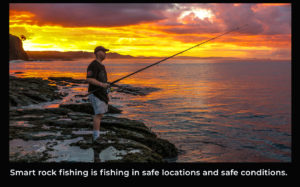
Fishing off the rocks can be an exhilarating and adventurous pastime. It is not only the thrill of big catches but the awe of hiking to beautiful locations, the feeling of solitude and relief from the pressures of life.
Rock fishing can also be extremely dangerous and sadly many people have died while pursuing their passion on ledges and rocky outcrops. It is not a place for the inexperienced when the location or conditions start to become risky. Smart rock fishing is about making smart choices – choose a location that doesn’t involve obvious risks such as big swells, high ledges or strong currents. Life jackets are useful and can save lives but fishers are best to fish in locations and conditions that don’t require the aid of a life jacket should they fall in.
There are clear dangers when rock fishing, the first one is the swell. Check the swell (e.g. swellmap.co.nz is a good place to start) before you go fishing and think about how the forecast will affect the place you are fishing. Services like Swellmap will forecast how high the swell will likely be. You do not want to be fishing a ledge that has heavy swell sweeping over your fishing location. A few splashes on your feet is not the same as a wall of green water coursing over the rocks with a thunderous boom. Learning the difference is important. Generally, onshore winds will make conditions more dangerous by driving waves onto land and offshore winds will flatten down the waves making things calmer.
When you first arrive at your fishing spot, take some time to first watch the waves. Any rocks that are wet mean they have been splashed or swept by waves. Figure out where the safe spots are and also think about what would happen if someone fell in. What is the safety procedure? Where do you get out of the water? What does your mate do to help? If you’re fishing a location that doesn’t look like you could safely get out of the water, maybe think about fishing somewhere else. Take two forms of communication and check the reception on your phone and radio before you cast your line out.
Wearing a life jacket is a smart idea in remote places or where getting out of the water is difficult because of heavy current and swell. A smarter choice is fishing where a life jacket isn’t required. The west coast is generally considered the kind of place everyone should wear a life jacket. Watch out for slippery rocks and wear sturdy footwear with decent grip. A first aid kit is also a smart idea and especially useful if someone falls over and cuts themselves.

Always fish with a mate. This is really the supreme rule of rock fishing. A mate can help you get out of trouble or raise the alarm and get help if something happens. It’s hard to call for help when you’re in the water and your phone is safely in your pack if you’re fishing solo. Always tell someone where you are going and when you will be home. You don’t have to tell them your secret fishing location but if you need rescuing, the search parties will need a place to start looking. Hopefully with the right precautions and common sense, you will never need rescuing.


